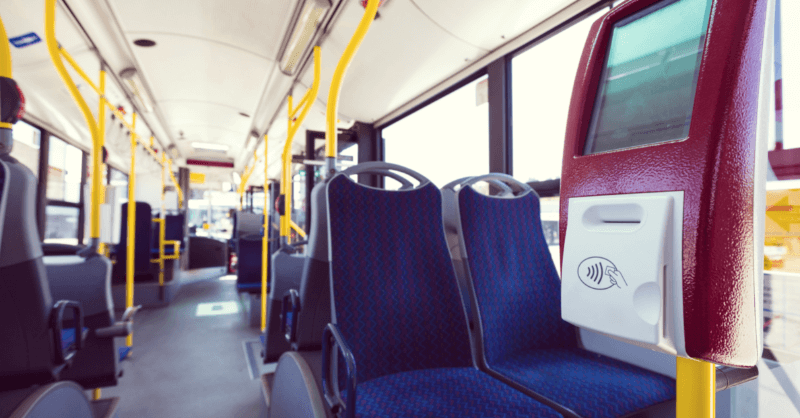Public transport and mobility are experiencing an exciting renaissance.
Multi-operator cEMV as part of an Integrated Mobility Solution. Public transport and mobility are experiencing an exciting renaissance. The total mobility landscape is changing; from the transport options available to the way passengers discover and pay for their journey. New challenges are brought to the surface as the old way of doing things meets the new. One key challenge is how to unite multiple operators across multiple modes, with different and dispersed back offices and payment solutions. This increase in options for passengers complicates how journeys are discovered, planned and paid for. As a result, there is a demand from consumers for a consolidated and simplified approach.
Bus Back Better
The Bus Back Better initiative that was launched earlier in the year requires local authorities to gain a better insight into how passengers travel in their jurisdiction. As part of the scheme, LAs should aim to offer passengers improved and more relevant services. Consolidating passenger journey data also allows the authorities to report back to the central government and demonstrate the success of their initiatives. One of the most talked-about solutions to this challenge is the use of Contactless EMV (cEMV). It is being offered up as an effective tool for multi-operator products and unifying passenger travel data. Whilst it is not a silver bullet solution, cEMV plays an important role as part of a wider universal integrated mobility platform.
At UrbanThings, we can see the value of using cEMV as a flexible, multi-operator, fare collection technology. We’re constantly looking as to how contactless EMV would be best integrated into UrbanHub, our MaaS platform for cities and operators.
The Multi-operator Dilemma
Passengers want (and need) a simplified experience for their journeys, and Bus Back Better now mandates seamless multi-operator fares. However, this creates a dilemma; each operator has their own separate fare structures, onboard hardware, application solution and back office. These have been deployed over multiple years with different configurations and using different technologies. Consequently, there is no simple, innate, cross-compatibility to allow for multi-operator fares to be instantaneously enabled. A solution is required to unify these both onboard; with the fare validation hardware, and offboard; within the back office and payments.
Now, more than ever, there is a demand for collaboration and cross-compatibility between different operators within a city region.

Currently, there are three potential technologies that could enable multi-operator fare collection. These are ITSO, QR and cEMV. Each presents its own benefits as well as a number of further challenges and complications.
- ITSO: Perhaps the most traditionally favoured option would have been ITSO. However, this would require a combination of complex CRM and HOPS integrations. It would also require passengers to carry an additional piece of plastic around with them. This would also create a dilemma as to where the account and financial balance resides. Would a new HOPS be created alongside the existing individual operator’s HOPS?
- QR: Utilising QR readers is theoretically ideal. They don’t create any throw-away media and utilise devices that passengers readily carry around: their mobile phones. However, there are two core gaps. Firstly, there are multiple prevailing QR standards so there is no ‘one-size-fits-all’ option. Secondly, bus operators have different configurations in QR reading technology. These range from different hardware technologies to no hardware installed at all. It would be costly to ensure that compatible hardware was installed on all vehicles within a multi-operator scheme. This would also then lock down the scheme to one single supplier and limit the scheme to a particular area that shares hardware.
- cEMV: Contactless payments and EMV cards appear to be the most universal and flexible solution. 83% of people in the UK are already carrying a cEMV card either in the form of a contactless bank card or a bank card within their Apple or Google wallets. Likewise, operators have equipped a majority of vehicles with cEMV compatible readers. As a result, it could be enabled rapidly for a large number of passengers and vehicles across multiple operators.
cEMV for Multi-operator Fare Collection
There are two main approaches to implementing multi-operator cEMV fare collection. They stem from the same methods used today in many single-operator deployments.
- The first of these is ‘Pay As You Go (PAYG)’, where a passenger simply taps their card as they travel and a back-office calculates the applicable fare at the end of their travel period, sometimes with daily or weekly capping applied.
- The second is cEMV model 3, where passengers purchase a fare that is attributed to their bank card as a token to travel.
Both of these models have the potential to work in a multi-operator configuration. This is provided that a back-office integration exists to pass tap data between operators and join up all stages of the journey. Theoretically then, this means that cEMV multi-operator travel could be deployed today using existing hardware through a back-office upgrade.
cEMV Limitations
There are still limitations to cEMV, and this is where it can become a component in a broader mobility platform, such as UrbanHub, and not a solution in and of itself. cEMV multi-operator fare collection, using the current configuration, has three fundamental shortcomings which require a more complete mobility platform to resolve.
- Multiple Apps: Where cEMV is deployed as a multi-operator ticketing solution, each operator still has its own application with separated RTI, fare and capping information. A passenger may still need to use multiple applications to manage a single journey.
- Data Anonymity and Account Ownership: cEMV card taps made throughout the system are anonymous. In order to attribute cEMV journeys to a passenger account, their card must be linked. However, with multiple separate applications and back offices, comes multiple separate accounts. This makes it hard to provide a transparent and a seamless passenger experience. It also blurs the Authority’s view of passenger activity as they cannot link journeys together to understand how people are moving around their region.
- Those without cEMV – A fundamental gap in an all-EMV solution is how to serve those without a contactless bank card or smartphone. These riders would be excluded in a cEMV solution preventing an authority from meeting its equity of service obligations.
Alongside these multi-operator constraints, it is also impractical in many cases to integrate into other modes such as scooter and bike-sharing.
Together, these gaps indicate that cEMV is not suitable as a complete and effective mobility solution alone. This is where it becomes a powerful tool within a wider mobility solution for modernising public transport offerings. Utilising cEMV as a tool within a complete mobility platform is the best solution to the multi-operator and cross-modal dilemma.

A Fully integrated and complete platform with cEMV
A universal and complete solution to solve the multi-operator and cross-modal dilemma is to employ cEMV as a component of a full mobility platform. This way, it can be leveraged for its strengths, whilst all the stakeholders are still served by the platform. A full multi-operator, cross-modal mobility solution goes beyond just ticketing and payments. The platform should also provide a suite of supporting passenger tools including:
- Journey planning
- Real-time information and updates
- Direct passenger communication
- Passenger support
- Account and journey management
As outlined earlier, cEMV is a great solution for the majority of account-based payments. This can be integrated alongside a pre-paid ticketing back office for printed media or provisioned Private Label EMV cards. A passenger application providing journey planning, RTI and passenger support can also be deployed as a component of the platform. Finally, a link to a central platform ties everything together.
Passengers can plan a journey with the app, tap their cEMV card for the right to travel, and then receive direct in-app notifications of the journey and charges as they happen; including when they reach a daily or weekly cap.
Modern, innovative MSPs can be included, such as e-bikes or scooters, where the app can be used to unlock docked vehicles or make additional card payments. These can also benefit from the same capping schemes if required.
Full equity of service is provided by allowing passengers without a contactless bank card to purchase printed single tickets via a web portal or retail outlet. Alternatively, they can be issued with a private label EMV card to provision with passes via the web portal in a Model 3 configuration.
Overall, cEMV represents a vital and incredibly useful tool in the enablement of multi-operator mobility. However, due to a number of limitations, it cannot be relied upon as a complete and universal solution. Instead, it should be deployed as a key component within a fully-integrated MaaS platform such as UrbanHub. This then combines a suite of technologies supported by that central platform. A platform that combines cEMV, alongside a mobile application, web solution, sustainable printed media options and a fully-integrated back office will provide Local Authorities with the ability to serve all stakeholders whilst remaining flexible to changes in demand, technology and policy.
Get in touch with the UrbanThings team to learn more about the Mobility Charter, and how we can help you with your Local Authority or City’s BSIP.

